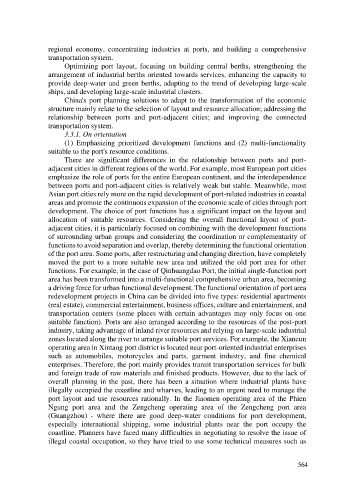Page 572 - Ebook HTKH 2024
P. 572
regional economy, concentrating industries at ports, and building a comprehensive
transportation system.
Optimizing port layout, focusing on building central berths, strengthening the
arrangement of industrial berths oriented towards services, enhancing the capacity to
provide deep-water and green berths, adapting to the trend of developing large-scale
ships, and developing large-scale industrial clusters.
China's port planning solutions to adapt to the transformation of the economic
structure mainly relate to the selection of layout and resource allocation; addressing the
relationship between ports and port-adjacent cities; and improving the connected
transportation system.
3.3.1. On orientation
(1) Emphasizing prioritized development functions and (2) multi-functionality
suitable to the port's resource conditions.
There are significant differences in the relationship between ports and port-
adjacent cities in different regions of the world. For example, most European port cities
emphasize the role of ports for the entire European continent, and the interdependence
between ports and port-adjacent cities is relatively weak but stable. Meanwhile, most
Asian port cities rely more on the rapid development of port-related industries in coastal
areas and promote the continuous expansion of the economic scale of cities through port
development. The choice of port functions has a significant impact on the layout and
allocation of suitable resources. Considering the overall functional layout of port-
adjacent cities, it is particularly focused on combining with the development functions
of surrounding urban groups and considering the coordination or complementarity of
functions to avoid separation and overlap, thereby determining the functional orientation
of the port area. Some ports, after restructuring and changing direction, have completely
moved the port to a more suitable new area and utilized the old port area for other
functions. For example, in the case of Qinhuangdao Port, the initial single-function port
area has been transformed into a multi-functional comprehensive urban area, becoming
a driving force for urban functional development. The functional orientation of port area
redevelopment projects in China can be divided into five types: residential apartments
(real estate), commercial entertainment, business offices, culture and entertainment, and
transportation centers (some places with certain advantages may only focus on one
suitable function). Ports are also arranged according to the resources of the post-port
industry, taking advantage of inland river resources and relying on large-scale industrial
zones located along the river to arrange suitable port services. For example, the Xiancun
operating area in Xintang port district is located near port-oriented industrial enterprises
such as automobiles, motorcycles and parts, garment industry, and fine chemical
enterprises. Therefore, the port mainly provides transit transportation services for bulk
and foreign trade of raw materials and finished products. However, due to the lack of
overall planning in the past, there has been a situation where industrial plants have
illegally occupied the coastline and wharves, leading to an urgent need to manage the
port layout and use resources rationally. In the Jiaomen operating area of the Phien
Ngung port area and the Zengcheng operating area of the Zengcheng port area
(Guangzhou) - where there are good deep-water conditions for port development,
especially international shipping, some industrial plants near the port occupy the
coastline. Planners have faced many difficulties in negotiating to resolve the issue of
illegal coastal occupation, so they have tried to use some technical measures such as
564

